Results
-
 £176.50
£176.50Four Norfolk Dances - Philip Sparke
Norfolk is one of the most beautiful counties in England, famous for its charming villages and boundless broads, a popular centre for sailing holidays. It is also the home of one of the best known of all British composers, Sir Malcolm Arnold. The date of the premiere of this piece was to fall close to his 80th birthday, so Philip Sparke decided to write something of a birthday tribute. Some of Arnold's best-loved orchestral works are his sets of dances: there are two sets of English Dances, Four Scottish Dances, Four Cornish Dances etc., most of which have been arranged for concert band at one time or another. Philip Sparke thought it would be appropriate for the concert band tohave its own set of dances and wrote Four Norfolk Dances very much in the style of Arnold's suites.
Estimated dispatch 7-14 working days
-
 £89.99
£89.99Montana Fanfare (Concert Band - Score and Parts)
This piece was composed as a birthday present for the Austrian conductor Walter Rescheneder to acknowledge the strong support he has given to the composer, Thomas Doss. Doss drew the inspiration for this fanfare from a mountain hike in the Salzkammergut. A powerful fanfare reveals enthusiasm and triumph. It is an exulting feeling and gives boundless freedom to look down into the depths from high up giving a view of the stunning landscape. The main melodic theme represents the feeling of vastness one experiences by taking just one quick glance into the distance. A musical treat! 03:50
Estimated dispatch 7-14 working days
-
 £89.99
£89.99Montana Fanfare - Thomas Doss
This piece was composed as a birthday present for the Austrian conductor Walter Rescheneder to acknowledge the strong support he has given to the composer, Thomas Doss. Doss drew the inspiration for this fanfare from a mountain hike in the Salzkammergut. A powerful fanfare reveals enthusiasm and triumph. It is an exulting feeling and gives boundless freedom to look down into the depths from high up giving a view of the stunning landscape. The main melodic theme represents the feeling of vastness one experiences by taking just one quick glance into the distance. A musical treat!
Estimated dispatch 7-14 working days
-
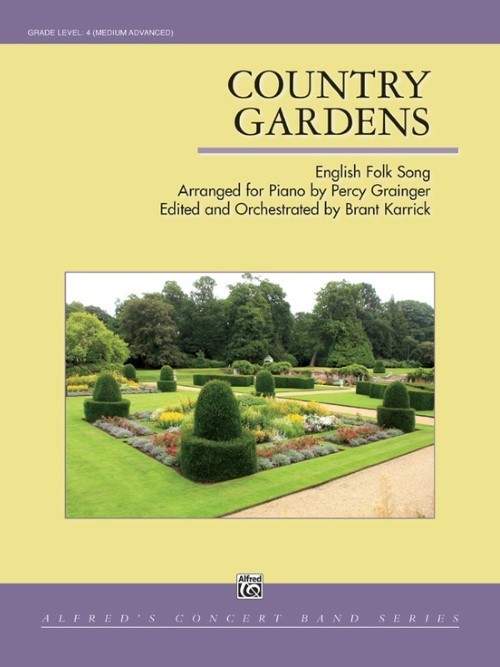 £78.00
£78.00Country Gardens (Concert Band - Score and Parts) - Grainger, Percy Aldridge - Karrick, Brant
Grainger's first piano arrangement of this English morris dance tune was completed in 1918 as a birthday gift for his mother. It became extremely popular and was his greatest commercial and financial success. Even this simple tune displays his genius with harmony, counterpoint, and colour. This very playable arrangement is an excellent way to introduce your students to the music of Percy Grainger.Duration: 2:10
Estimated dispatch 7-14 working days
-
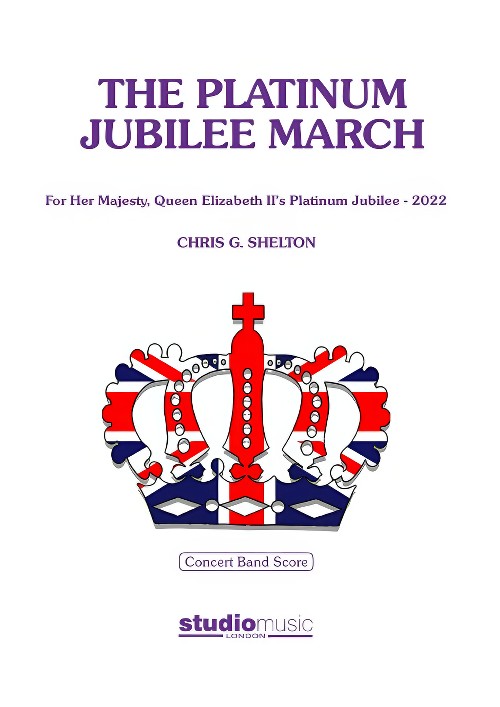 £17.95
£17.95The Platinum Jubilee March (Concert Band - Score only) - Shelton, Chris G.
Queen's Birthday Parade, Quick Troop 2022The Platinum Jubilee March was written to celebrate Her Majesty, Queen Elizabeth II's seventy-year reign as monarch of the United Kingdom. Its premiere was televised live around the world as part of the Queen's Birthday Parade which marked the start of the national Platinum Jubilee celebrations.The Queen's Birthday Parade 2022 saw the First Battalion of the Irish Guards trooping their colour. To reflect this, the march begins in a celebratory style and features a melody based around the opening motif of Let Erin Remember - the regimental slow march of the Irish Guards. In traditional style, the march develops excitement both harmonically and melodically, creating a strong sense of drive before reaching a stately trio. This section has a very regal and noble feel, lending subtle harmonic nods to two of the most quintessentially British composers, Gustav Holst, and Sir William Walton. The march culminates in a bold grandioso, featuring florid woodwind lines that are underpinned by a driving trombone and horn countermelody. A forthright restatement of the introductory fanfare brings the march to a very definite and resolved ending.Duration: 3.30
Estimated dispatch 7-14 working days
-
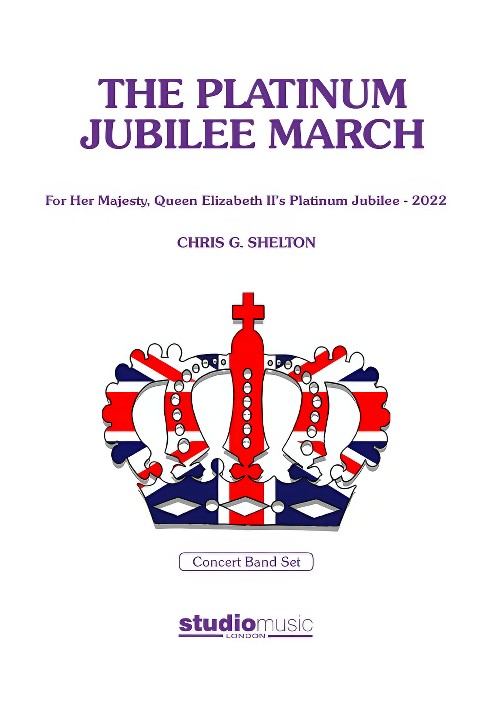 £87.95
£87.95The Platinum Jubilee March (Concert Band - Score and Parts) - Shelton, Chris G.
Queen's Birthday Parade, Quick Troop 2022The Platinum Jubilee March was written to celebrate Her Majesty, Queen Elizabeth II's seventy-year reign as monarch of the United Kingdom. Its premiere was televised live around the world as part of the Queen's Birthday Parade which marked the start of the national Platinum Jubilee celebrations.The Queen's Birthday Parade 2022 saw the First Battalion of the Irish Guards trooping their colour. To reflect this, the march begins in a celebratory style and features a melody based around the opening motif of Let Erin Remember - the regimental slow march of the Irish Guards. In traditional style, the march develops excitement both harmonically and melodically, creating a strong sense of drive before reaching a stately trio. This section has a very regal and noble feel, lending subtle harmonic nods to two of the most quintessentially British composers, Gustav Holst, and Sir William Walton. The march culminates in a bold grandioso, featuring florid woodwind lines that are underpinned by a driving trombone and horn countermelody. A forthright restatement of the introductory fanfare brings the march to a very definite and resolved ending.Duration: 3.30
Estimated dispatch 7-14 working days
-
 £84.99
£84.99Let's Celebrate Wind Band Set (Score & Parts)
Is there something to be celebrated? Then let's play 'Let's Celebrate'! This four-part suite has been based on two birthday songs: the world-famous 'Happy Birthday to you' (which is also sung in many other languages), and the Dutch song 'Lang zal hij/zij leven'. The Fanfare opens in grand style with the motif of 'Lang zal hij leven' and is followed by a cheerful March in which the motifs of both songs can be heard. The third part, Song, forms a moment of contemplation, and the birthday presents are unwrapped by the percussion section in the fourth part, Surprise Party. The yell may be adapted to the occasion. (the sleigh bells caused the composer to note down this somewhat peculiar yell). Of course everybody is expected to join in. 07:00
Estimated dispatch 7-14 working days
-
 £84.99
£84.99Let's Celebrate - Dagmar Kildevann
Is there something to be celebrated? Then let's play 'Let's Celebrate'! This four-part suite has been based on two birthday songs: the world-famous 'Happy Birthday to you' (which is also sung in many other languages), and the Dutch song 'Lang zal hij/zij leven'. The Fanfare opens in grand style with the motif of 'Lang zal hij leven' and is followed by a cheerful March in which the motifs of both songs can be heard. The third part, Song, forms a moment of contemplation, and the birthday presents are unwrapped by the percussion section in the fourth part, Surprise Party. The yell may be adapted to the occasion. (the sleigh bells caused the composer to note down this somewhat peculiar yell). Of course everybody is expected to join in.
Estimated dispatch 7-14 working days
-
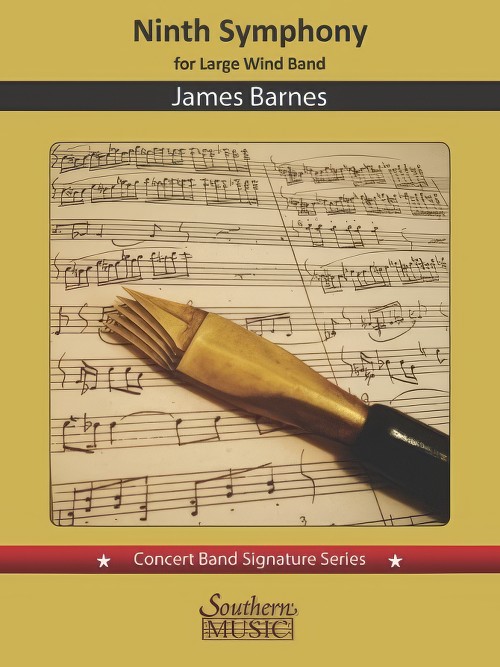 £309.99
£309.99Ninth Symphony (Concert Band - Score and Parts) - Barnes, James
Premiered on 21 September, 2018 in Lawrence, Kansas by The University of Kansas Wind Ensemble (Dr. Paul Popiel, conducting), James Barnes' Ninth Symphony was composed between January and late June of that same year. This large work was commissioned by a consortium of twenty-one college bands, community bands, professional bands and individuals to help mark the 70th birthday of the composer (b. 1949). It is an expansive forty-minute work in four movements, of which the composer writes, "This is my last symphony...this work represents a compendium of all that I have learned during the fifty years of composing and scoring for this wonderful new medium: the modern wind band." The first movement, subtitled Elegy, is based around G minor. It is the longest movement of the symphony. Tragic and despondent in character, it is cast in sonata-allegro form. The second movement is entitled Scherzo. Barnes claims that "I have always wanted to write a waltz," and that is how this movement is cast, in a modified rondo form in D minor. In contrast to the mood of the first movement, the scherzo is a delightful posy of expansive melody, splashy color, humor and rhythm. The third movement, which is in a modified tertiary form, is entitled Night Music. In contrast to the scherzo, this movement begins with a mysterious incantation, first displayed by solo Alto Flute. The music becomes even darker and more mysterious, while overall the movement effectively expresses an "otherworldly" mood, ending with a solo soprano offstage which suddenly emerges, eerily singing a modified version of the opening incantation. Cast in sonata-allegro form, the fourth movement is most definitely a rousing Finale, beginning with a brilliant fanfare and undergoing several mood transformations before emerging into the final coda, ending the symphony with an energetic splash of color. Duration: 40.00
Estimated dispatch 7-14 working days
-
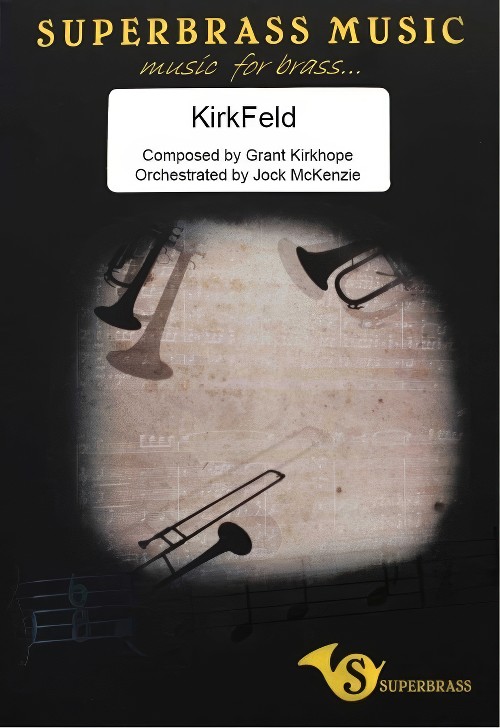 £125.00
£125.00KirkFeld (Trombone Solo with Concert Band - Score and Parts) - Kirkhope, Grant - McKenzie, Jock
Written for Ian Bousfield and the International Trombone Festival 2017. Grant Kirkhope is a BAFTA nominated British composer who has created the soundtrack for video games that have sold in excess of 30 million copies. From "GoldenEye" to "Banjo-Kazooie", "Viva Pi?ata" to "Donkey Kong", "Kingdoms of Amalur: Reckoning" to "Civilization: Beyond Earth" and "Perfect Dark" to "Castle of Illusion starring Mickey Mouse". He has also recently scored the feature film "The King's Daughter" starring Pierce Brosnan and William Hurt and is currently working on "Yooka Laylee" and "Dropzone". Grant's score for "Viva Pi?ata" was nominated by BAFTA in the Original Score category in its 2007 awards. Grant is represented by the prestigious Gorfaine/Schwartz Agency by Cheryl Tiano and Kevin Korn. Grant has a degree in music from the Royal Northern College of Music, Manchester, where he majored in classical trumpet, is a green card holder and now lives in Agoura Hills, LA with his wife and two children. "Ian and I first met when we were around 15 years old. We both played in our county orchestra, the North Yorkshire Schools Symphony Orchestra (I was a trumpet player). I think we hit it off straight away, as we were definitely a couple of cheeky kids, if you know what I mean! We both ended up playing in Rowntree Mackintosh Brass Band for a while too which Ian's Dad, Trevor conducted. We bumped into each other again when we both went for the Shell/LSO Scholarship. I got to the area finals in Manchester so I was pretty pleased with myself but then I saw Ian and I knew it was all over! Of course Ian went on to win and the rest is history. I saw him again when I was attending the Royal Northern College of Music around 1983 by which time Ian had just got the principal chair at the Halle Orchestra. Then I guess 30 something years went by as we both went about our lives and lost touch. We re-kindled our friendship due to his wife really. She emailed me to say it was Ian's 50th birthday and she was collecting stories from all his friends over the years. After that we got back in touch and then one day on Facebook I got a message from him in typical dry Yorkshire fashion "now then Grant, I had a listen to your music and I think it's good, how about writing a piece for me ?" I was a little bit unsure at first but of course I loved Ian's playing and of course I said yes. Over a Skype call in 2016, he asked me what I thought I'd write. I said since I live in LA I'd like to write a "Hollywood" trombone piece. Imagine if John Williams had written a piece for solo trombone, that's what I'd like to write - well I'd certainly like to try" - Grant Kirkhope
Estimated dispatch 7-14 working days
